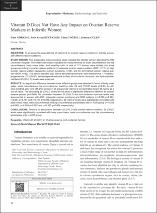Vitamin D does not have any impact on ovarian reserve markers in infertile women

View/
Access
info:eu-repo/semantics/openAccessinfo:eu-repo/semantics/openAccessDate
2017Metadata
Show full item recordCitation
Görkem, Ü., Küçükler, F. K., Toğrul, C., Gülen, Ş. (2017). Vitamin D does not have any impact on ovarian reserve markers in infertile women. Gynecology Obstetrics & Reproductive Medicine, 23(2), 79-83.Abstract
OBJECTIVE: To evaluate the potential role of vitamin D on ovarian reserve markers in infertile women with different reserve patterns.
STUDY DESIGN: This prospective cross-sectional study included the infertile women attending the Hitit University Hospital. The initial examination included the measurements of waist circumference and hip circumference, body mass index, and waist/hip ratio. A total of 171 women were divided into three groups according to ovarian reserve patterns: (i) adequate ovarian reserve pattern (AOR, n=77), (ii) high ovarian reserve pattern (polycystic ovarian syndrome, n=62), and (iii) diminished ovarian reserve pat-tern (DOR, n=32). The serum estradiol (E2), follicle stimulating hormone, total testosterone, 17-hydroxy-progesterone (17 (OH) P), dehydroepiandrosterone sulfate, anti-mullerian hormone, and hydroxychole-calciferol (25 (OH) D) levels were analyzed.
RESULTS: No significant difference between three different groups was detected in terms of body mass index, waist circumference, hip circumference, waist/hip ratio, E2 and 17OHP levels (p>0.05, for all). One-hundred-sixty-nine (98.2%) women in all groups had vitamin D concentration below 30 ng/mL as a cut-off value. The circulating 25 (OH) D levels did not show a significant difference between all ovarian reserve groups (p=0.804). No correlation between 25 (OH) D and anti-mullerian hormone levels was documented in women with AOR, polycystic ovarian syndrome and DOR patterns (r=-0.099 p=0.393, r=0.034 p=0.794 and r=0.157 p=0.390 respectively). 25 (OH) D levels were significantly correlated with body mass index, waist circumference and hip circumference parameters only in AOR group (r=-0.355 p=0.002, r=-0.305 p=0.007 and r=-0.322 p=0.004 respectively).
CONCLUSIONS: There is no association between 25 (OH) D and ovarian reserve markers. 25 (OH) D levels were significantly correlated with body mass index, waist circumference and hip circumference parameters only in AOR group.
Source
Gynecology Obstetrics & Reproductive MedicineVolume
23Issue
2Collections
- Makale Koleksiyonu [524]
- TR-Dizin İndeksli Yayınlar Koleksiyonu [1602]

















